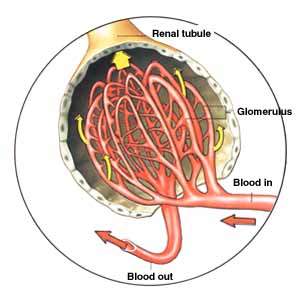Blood flows through tiny capillaries in the kidney
With Type 2 diabetes, we need to keep one thing clearly in mind: Insulin is a growth hormone. As long as the body is producing insulin, high blood sugar counts cause relatively little damage. It’s the body’s attempt to bring these counts down by producing more insulin that causes the damage and ultimately affect ones heart.
Perhaps you’ve heard that diabetics can have trouble with their eyes, their kidneys, and the healing of wounds or ulcers, especially on their feet. The reason is that, in these areas, blood flows through extremely small vessels.
The kidneys, for example, are a vast network of tiny vessels called arterioles and capillaries, many of which are so small that only one blood cell can pass through them at a time.
What happens then when excess insulin causes the walls of these vessels to thicken? They quickly become blocked. Once a vessel is blocked, it dies. That’s why the circulatory system of a person with uncontrolled diabetes looks like a dying tree. All the tiny buds at the ends of the branches disappear, then the shoots from which the buds would have sprouted, then the smallest branches, and so on.
When I look at an MRI of someone with advanced diabetes, the patient’s main arteries may look fine, but thousands upon thousands of the system’s smallest branches have simply disappeared. The “tree” of a diabetic’s circulatory system has become nothing but a trunk and a few denuded branches. What’s more, that vast network of small vessels in the kidneys is actually used to filter waste products out of the blood. When this no longer functions, the diabetic needs to go on dialysis treatment — that is, they need to have their blood filtered by a machine.
Eye and foot problems are caused by the same withering of the cardiovascular system. When the body can’t supply enough blood flow to the rods and cones of the eye, these tissues die and the person can become blind. Likewise, when a diabetic gets a sore on his foot, it can turn into an ulcer that refuses to heal because there’s not enough blood supply to rebuild the tissue.
These conditions are rightly associated with diabetes, but their immediate cause is the destruction of the cardiovascular system. Diabetes and cardiovascular disease work together to deliver a 1-2 punch to the body’s most vulnerable systems.
Thank you for reading today’s post.
